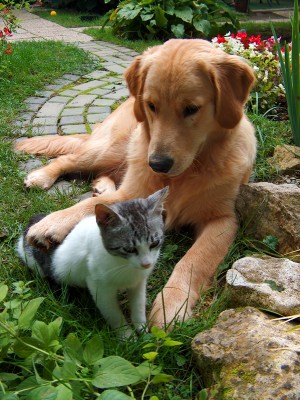Keeping a Pet-Safe Garden
 It’s that time of year again, when warmer temperatures and longer days make us head outdoors to spend more time in the fresh air and sunlight. If you happen to be a gardener, it’s probably also the time that you’re just itching to start digging in the dirt, and you may be deciding what flowers and veggies you may want to plant. It’s important to keep in mind that although gardening can be a very rewarding hobby, it can also be dangerous for our furry friends. Luckily, creating a pet-safe garden is not very difficult. We just need to take a few extra precautions to ensure that our yards and gardens are as safe as they are beautiful.
It’s that time of year again, when warmer temperatures and longer days make us head outdoors to spend more time in the fresh air and sunlight. If you happen to be a gardener, it’s probably also the time that you’re just itching to start digging in the dirt, and you may be deciding what flowers and veggies you may want to plant. It’s important to keep in mind that although gardening can be a very rewarding hobby, it can also be dangerous for our furry friends. Luckily, creating a pet-safe garden is not very difficult. We just need to take a few extra precautions to ensure that our yards and gardens are as safe as they are beautiful.
Avoid Poisonous Plants
The most obvious way to create a pet-safe garden is to choose the right plants. Not all pet owners realize that a great many garden plants are toxic to dogs and cats. Popular varieties such as azalea, rhododendron, oleander, foxglove, lily of the valley, sago palm, tulip and daffodil all fall into this category. Pets that eat these poisonous plants can experience everything from an upset stomach and diarrhea, to seizures and liver failure. Be sure to check the ASPCA’s comprehensive list of toxic plants before deciding which plants will make it into your garden.
While not toxic, it’s also a good idea to avoid trees, shrubs and plants that are likely to cause allergies. Many of the same plants that cause allergies in humans will affect your pet as well. Look for pollen-free plant species whenever possible. If you do select a plant with a high allergy potential, avoid planting it under windows that you’ll have open during the summer. If you already have one of these trees or hedges in your yard, keep it heavily sheared so it will flower less.
Choose Your Mulch Carefully
Many gardeners use cocoa bean mulch—a by-product of chocolate production—in landscaping. It has an attractive odor and color that make it a popular choice, but cocoa mulch can pose serious problems for your dog. To be safe, opt for shredded pine, cedar, or hemlock bark instead. Also try to avoid mulch that has been treated with weed inhibitor or insect repellent.
Rethink Toxic Chemicals
Try to avoid the use of chemical fertilizers, pesticides or weed killers in your yard and garden. These pose a danger to dogs and cats because anything picked up on their paws could be licked off later. There are plenty of organic, earth-friendly products available as an alternative that are safe for both pets and humans. Ask your local gardening center for recommendations and they should be able to point you in the right direction.
Insecticides are often necessary to keep our gardens healthy, but their ingredients aren’t safe for our furry friends. The most dangerous forms of pesticides include snail bait with metaldehyde, fly bait with methomyl, systemic insecticides with the ingredients disyston or disulfoton and most forms of rat poisons. Again, a conversation at your gardening center may be able to provide you with some effective but natural alternatives.
Compost Piles and Worm Bins
These eco-friendly practices can be great for your garden, but be sure they’re not accessible to your pets. Dogs that view garbage and rotting food as a special treat may consider this a buffet, but it’s one that could make them sick.
Garden Tools
Just like toddler-proofing, be sure to keep all pruning shears, trimmers, tillers, rakes and other gardening tools picked up and stored safely out of reach of your pets.
Gardening is a great hobby, and with a little extra planning and effort, it’s not difficult to ensure that your hobby will be safe for your pet.


